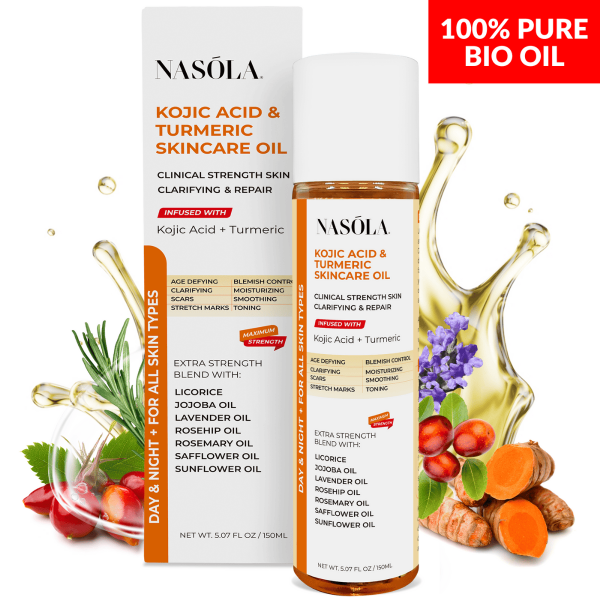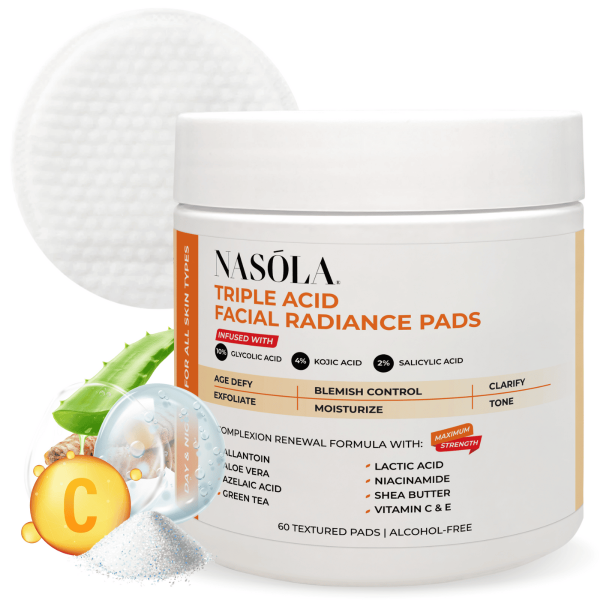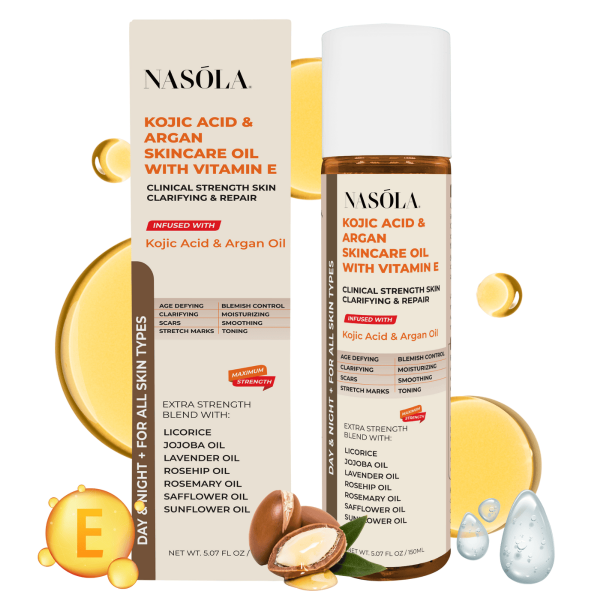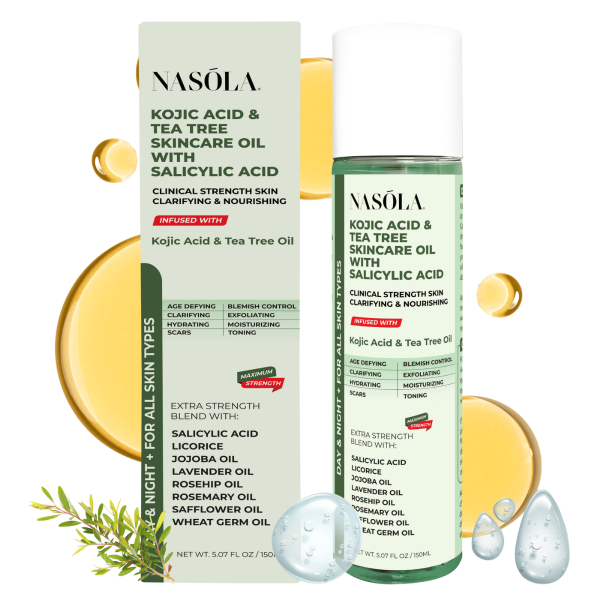Acne — ugh, right? It pops up right before a big event, overstays its welcome, and often leaves behind a little souvenir in the form of scars or pigmentation.
With the buzz around using an essential oil for acne, it’s no wonder more people are ditching harsh chemicals and turning to natural ways to combat breakouts. Essential oils are having a moment — and for good reason.
They’re botanical, effective, and when blended right, kind to your skin.
Now, let’s be honest: acne doesn’t just affect our skin, it hits our confidence. The scarring, redness, and endless frustration can be heavy — emotionally and physically.
But there is a way forward.
We’re diving into the best oils for acne and acne scars, unpacking the science, and giving you a look at how game-changing blends like the Nasola Kojic Acid + Tea Tree Skincare Bio Oil with Salicylic Acid can become your new skin BFF.
What Essential Oil is Good for Acne?
Let’s say it like it is—acne isn’t just a teenage problem. When you’re juggling work stress, hormonal changes, or pollution exposure, those tiny invaders start showing up again.
That’s when the question naturally bubbles up: what essential oil is good for acne?
Essential oils like tea tree, lavender, and turmeric don’t just smell amazing—they’re potent. Capable of cleaning pores, calming inflammation, and even reducing breakouts.
Especially when they’re part of a professionally balanced formulation with powerhouse ingredients like retinol and salicylic acid.
So, here’s how to use essential oils in your fight for clearer, calmer, more radiant skin:
Tea Tree Oil: A Natural Antibacterial Powerhouse
If you’ve ever Googled “best essential oil for acne,” tea tree oil is ALWAYS one of the top suggestions. Why? Because it knows exactly how to fight acne-causing bacteria without stripping your skin bone-dry.
When used consistently, tea tree oil:
- Reduces whiteheads and blackheads by unclogging pores.
- Calms inflammation and visibly reduces redness.
- Helps prevent future breakouts with antimicrobial action.
- Balances oil production without drying out skin.
The Nasola Kojic Acid + Tea Tree Skincare Bio Oil with Salicylic Acid is a standout here. It’s a carefully crafted trio of tea tree oil, salicylic acid, and retinol.
The salicylic acid sweeps through debris clogging your pores, the tea tree handles the bacteria, and retinol speeds up cellular renewal. Together?? It’s like an acne-fighting dream team.
Retinol and Salicylic Acid for Enhanced Oil Penetration
Tea tree oil works wonders on its own, sure. But when it’s paired with ingredients like salicylic acid and retinol? Whew, the transformation gets REAL.
That’s the secret sauce behind products that don’t just manage breakouts but truly change the texture and tone of your skin.
Salicylic acid penetrates deeply into the pores, exfoliating from the inside out. You’ll see fewer blackheads, smoother skin, and faster breakout recovery.
Meanwhile, retinol boosts your skin’s healing capability while stimulating collagen.
The synergy between essential oils like tea tree and active ingredients like salicylic acid makes for
seriously effective skincare.
Essential Oils for Acne Scars: Healing Beyond the Breakout
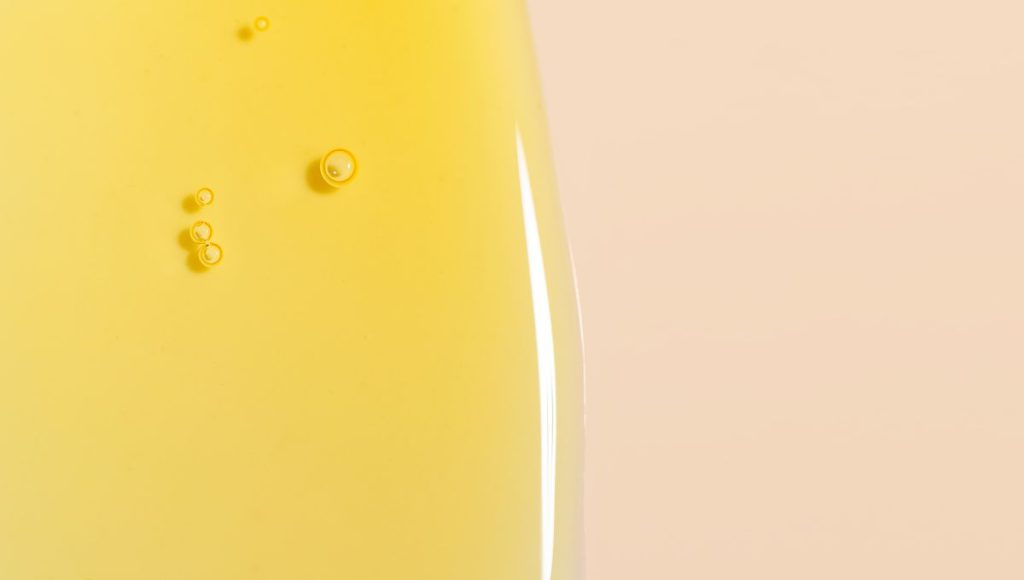
You beat the breakout — awesome! But now the real test starts: the battle against the scars left behind. Essential oils for acne scars can deliver major glow-up effects, reducing pigmentation and smoothing skin.
Two of my top picks? Lavender and argan oil. They don’t just moisturize. They do the deep, therapeutic work of skin healing. Let’s break it down:
Lavender Oil: Calm Inflammation and Promote Healing
Lavender oil is proof that gentle can be powerful. It’s best known for its calming scent, but on acne scarred skin? It works magic.
Lavender oil’s regenerative properties repair damaged cells and fade stubborn pigmentation.
Here’s what lavender oil can bring to your routine:
- Regenerates skin tissue, reducing the intensity of marks.
- Fades hyperpigmentation and acne-related spots.
- Improves skin elasticity and firmness.
- Relieves redness and swelling after breakouts.
While lavender oil alone is effective, combining it with kojic acid and retinol is next-level brilliance.
Product Spotlight: Nasola Kojic Acid + Argan Skincare Bio Oil
This oil is pure gold in a bottle. The Nasola Kojic Acid + Argan Skincare Bio Oil deeply hydrates while lightening post-acne scars. Argan oil is full of vitamin E, which promotes repair. Kojic acid handles the pigmentation. Retinol resurfaces your texture.
A triple-threat that leaves skin glowy and nourished? That’s a YES.
Ingredient Highlight: Kojic Acid’s Role in Skin Brightening
Let’s talk about this underrated brightener. Kojic acid is a natural compound derived from fermented rice. It reduces melanin (the pigment responsible for dark spots) by inhibiting the enzyme tyrosinase.
Here’s what it’s doing for your skin:
- Decreasing the appearance of discolored spots.
- Evening out your overall complexion tone.
- Supporting antioxidant protection—slowing down premature aging.
- Working synergistically with vitamin-rich oils to restore radiance.
Found in many Nasola Bio Oils, kojic acid is your gentle yet effective ticket to balanced, brighter skin.
Best Essential Oil for Acne-Prone Skin Types
Now that we’ve covered the basics, let’s talk about the real struggle: acne-prone skin types. They’re temperamental, reactive, and usually come with a list of “hard NO” skincare ingredients. That’s where essential oils shine.
Turmeric oil is one of the best essential oil for acne-prone skin types — it calms irritation while offering deep antioxidant support.
Combine that with retinol and gentle hydrators? You’ve got an acne warrior in a bottle.
Turmeric Oil: Antioxidant and Anti-inflammatory Champion
Turmeric. It’s not just for golden lattes and curries — this root is jam-packed with curcumin, a powerful anti-inflammatory compound that reduces redness and swelling from breakouts.
When used topically, turmeric oil:
- Soothes inflamed, irritated skin.
- Fights free radicals that age the skin.
- Enhances skin’s natural glow and brightness.
- Reduces formation of cystic acne and hormonal chin breakouts.
Perfect for acne-prone skin that needs gentleness and strength rolled into one.
Product Mention: Nasola Kojic Acid + Turmeric Skincare Bio Oil
This is another powerhouse formula. The Nasola Kojic Acid + Turmeric Skincare Bio Oil boasts turmeric oil, retinol and kojic acid for a triple-action punch.
It targets pigmentation from older breakouts, clears new spots, and hydrates flaky skin. Smooth glide, no greasy after-feel, and visible results — quick.
Use it daily after cleansing and your skin will feel like it just had a facial.
Vitamin A (Retinol): Ingredient Breakdown
Let me say this — if your acne routine doesn’t include retinol… it’s missing a key player.
What makes retinol so powerful?
- Accelerates cell turnover so fresh, clear skin can surface faster.
- Clears clogged pores and diminishes blackheads.
- Fades acne scarring and reduces fine lines.
- Helps all other ingredients—like essential oils—penetrate deeper and work smarter.
Best of all, every Nasola Bio Oil has retinol built in. So, you’re treating today’s pimples AND preventing tomorrow’s scars.
Retinol-Powered Essential Oil for Acne Treatments
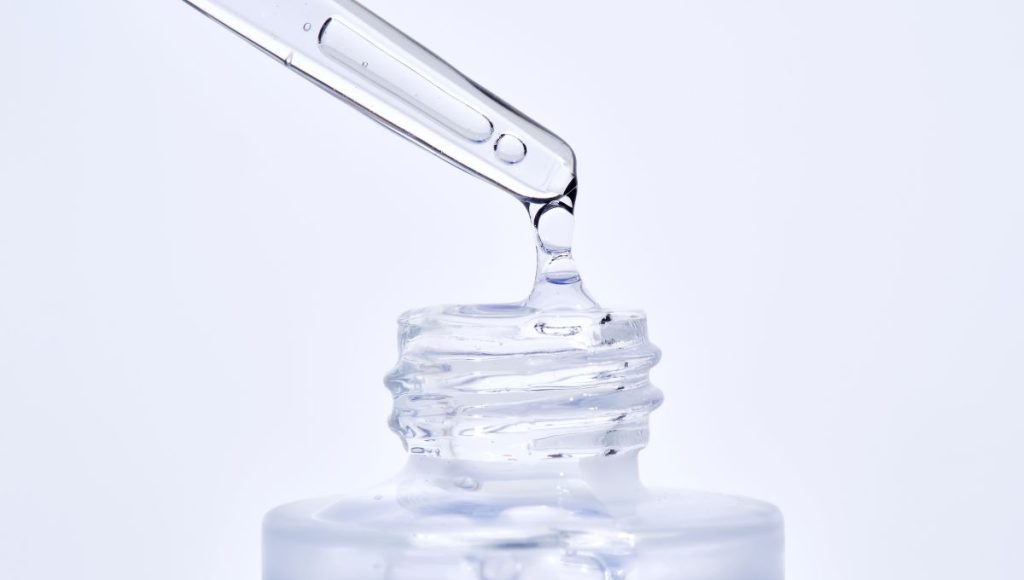
There’s essential oil solutions — and then there’s retinol-powered essential oils. Combining nature and skincare science makes all the difference when your acne won’t budge or your scars scream louder than your glow.
Here’s how these advanced formulas bring real change to your skin:
How Retinol Stimulates Collagen and Fades Scars
If building smoother, stronger skin is part of your goal (and I KNOW it is), retinol can’t be skipped. It’s a vitamin A derivative that stimulates fibroblasts — cells that produce collagen and elastin.
Paired with essential oils, it works even better by:
- Soothing inflammation that would usually accompany retinol’s irritation.
- Allowing longer use with less redness.
- Improving skin’s receptiveness to deeper hydration.
- Enhancing overall texture change.
Apply a thin layer of any Nasola Bio Oil and you’re not just moisturizing—you’re regenerating.
Triple-Action Support: Nasola Triple Acid Facial Radiance Pads
Look—if you want NEXT-LEVEL glow, exfoliation is your bestie.
The Nasola Triple Acid Facial Radiance Pads are pre-soaked cotton pads drenched in glycolic, salicylic, and lactic acids. These beauties:
- Slough away dead skin so oils absorb better.
- Unclog pores and remove blockages.
- Fade post-acne marks and balance tone.
- Preps your skin for deep hydration from your Nasola Bio Oil.
Basically? They’re an essential pre-step for superior results.
How to Safely Use Essential Oil for Acne
Essential oils seem harmless, right? But don’t underestimate their potency. They’re incredibly concentrated and can irritate or damage sensitive skin if used improperly.
To get the benefits without the burn, it’s important to use them correctly. Here’s how:
Carrier Oils Matter: Avoiding Irritation
You can’t just dab on undiluted lavender or turmeric oil and hope for the best.
Carrier oils are crucial for:
- Diluting potency to safe, skin-friendly levels.
- Adding hydration that balances acne-targeted actives.
- Helping essential oils spread evenly for better coverage.
- Preventing burns, rashes, or peeling.
Nasola Bio Oils already include perfectly balanced blends with carrier oils AND actives. There’s zero guesswork—just apply, glow, repeat.
Patch Testing and Skin Sensitivity
Before you go all-in, do a patch test—especially if you’re new to essential oils. Try a small amount behind your ear or on your inner arm.
Look out for:
- Redness, itching, or flaking after 24–48 hours.
- Stinging or tightness that doesn’t fade.
- Bumps or breakouts in areas of application.
- Any allergic flare-ups — listen to your skin.
Patience and consistency are KEY. Natural formulas take time to show magic, but that glow is worth it.
Conclusion
So yes—using an essential oil for acne isn’t just a trend…it’s a lifestyle upgrade. Whether you’re mid-breakout or managing leftover scars, essential oils, when paired with powerhouse ingredients like kojic acid and salicylic acid, offer relief and renewal in one skin-loving punch.
With powerhouse products like the Nasola Kojic Acid + Tea Tree Skincare Bio Oil with Salicylic Acid, the brightening Nasola Kojic Acid + Argan Skincare Bio Oil, or the calming Nasola Kojic Acid + Turmeric Skincare Bio Oil, you don’t just treat acne—you rebuild your skin’s future.
So if you’re over skin regrets? Try skin resets instead.
Enjoy the journey. Be patient. Stay radiant.
Frequently Asked Questions (FAQs)
Tea tree oil is widely considered one of the best essential oils for acne due to its antibacterial and anti-inflammatory properties. It kills acne-causing bacteria and reduces redness. Nasola’s Kojic Acid + Tea Tree Skincare Bio Oil is a great product that incorporates this essential oil along with retinol and salicylic acid for enhanced results.
Lavender and argan oil are top picks for acne scars as they support skin regeneration and moisture retention. Argan oil, featured in Nasola’s Kojic Acid + Argan Skincare Bio Oil, helps heal damaged tissue and brighten dark marks.
Yes, when properly diluted or included in a professional formula like Nasola’s bio oils. Daily use allows healing ingredients like retinol and essential oils to work consistently on improving skin clarity and texture.
Absolutely. Its anti-inflammatory and antioxidant properties can reduce acne flare-ups and fade scars. The Nasola Kojic Acid + Turmeric Skincare Bio Oil is a potent blend designed specifically to address blemishes while enhancing skin glow.
Avoid using undiluted citrus oils and cinnamon oil as they can be irritating. Instead, choose soothing options like tea tree and lavender, ideally found in pre-formulated solutions such as those offered by Nasola.
Visible improvements typically begin in 2–4 weeks depending on the formulation and skin consistency. Products with added retinol, like those from Nasola, can accelerate this process.
Yes, this combination is effective but can be harsh if not properly balanced. Nasola’s bio oil products ensure the right ratios, minimizing irritation while amplifying results.
They serve different purposes. Salicylic acid exfoliates, while tea tree oil fights bacteria. The Nasola Tea Tree Skincare Bio Oil with Salicylic Acid gives you both for maximum acne control.
They can significantly reduce their appearance over time, especially when combined with brightening agents like kojic acid and retinol. Regular use of Nasola Kojic Acid + Argan Skincare Bio Oil supports long-term scar fading.
It’s best to use essential oils as part of an all-over treatment if breakouts are widespread, but spot-treating works well for isolated blemishes. Products like Nasola’s Triple Acid Facial Radiance Pads can also be used to target specific problem areas.


